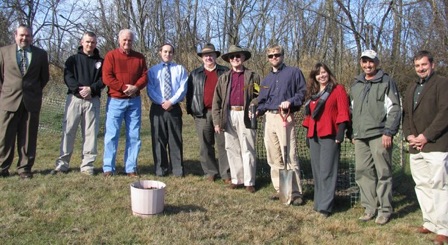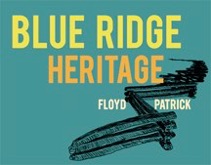BRHI’s Chestnut Program
In partnership with The American Chestnut Foundation

Left to Right: Tom Rose, Richard Turman, Joe Turman, Chris Collins, Dan Campbell, Steve Swartz, Matt Brinckman,
Tiffany Haworth, Wayne Kirkpatrick, Lauren Yoder.
Restoration Chestnut
Saplings Planted
On November 19, 2013, representatives from Senator Tim Kaine’s office, from Patrick and Floyd Counties, and from both The American Chestnut Foundation (TACF) and the Dan River Basin Association joined Directors of Blue Ridge Heritage, Inc. (BRHI) to plant two 15/16ths American chestnut hybrid trees on the BRHI property in the Rocky Knob area of Floyd and Patrick Counties.
One of the trees was donated to BRHI in memory of previous owner Mr. Bramley by his family; the other was donated by TACF. Last spring, 100 percent American chestnut saplings were planted to test soil and exposure locations in preparation for the introduction of the hybrid (blight-resistant) chestnut trees that will be gradually introduced to the site over the coming decades, in partnership with TACF. Of those ~30 American chestnut saplings planted 6 months ago, approximately 10 have survived, and organizers hope read more . . . Participating in the planting were: Chris Collins from Senator Kaine’s office; Joe Turman, Supervisor from Floyd Co.; Lauren Yoder, Supervisor from Floyd Co., Tom Rose, Administrator for Patrick Co.; Dan Campbell, Administrator for Floyd Co.; Tiffany Haworth, ED of the Dan River Basin Association (Patrick Co.); Matt Brinckman, Mid-Atlantic Regional Science Coordinator for TACF; Richard Turman from Floyd; and Steve Swartz, Lee Chichester, and Wayne Kirkpatrick of BRHI. “Part of Blue Ridge Heritage’s long-term plan,” says Steve Swartz, President of BRHI, “is to have a grove of these 15/16ths American, hybrid, Restoration chestnuts from The American Chestnut Foundation growing on this property for visitors to walk through. Our mission is to educate residents and visitors about 20th century life in these two counties, so our goal with this nascent Chestnut Program is to help us all understand what the loss of the chestnuts during the 20th century meant to the economies and culture of Floyd and Patrick Counties. In addition, it is meaningful for us all to understand more about the effort to restore the chestnut in America; and to experience some of the results of that effort.” “These trees, which are 15/16ths American chestnut, represent 6 or 7 generations of back-crossing the American chestnut with blight-resistant oriental chestnut trees,” Matt Brinckman explains. “With each generation, we have ‘challenged’ the saplings with the blight, which means: we inject them with the blight. Those trees that survive the challenge are allowed to produce seed for the next generation, which is carefully crossed again with the native American chestnut. “TACF has been working on this hybrid strain for decades, and we hope each tree sprouted from these nuts will be blight-resistant. We cannot be sure, however, that this is the final strain,” he cautions. “These are a test generation, and by planting them here today, their ability to survive or the stressors to which they are subject, if they do not survive, will be important data for our research.” The planting took place after introductions and Q&A. Collins, Haworth, and Swartz planted one of the saplings; while Turman (Joe), Rose, and Brinckman planted the other. The guests participated in watering, fencing, and other details while networking and chatting amongst themselves.
-
New Growth
https://brheritage.org/wp-content/uploads/2018/06/VHS2-450x338.pngScientists study the new growth on an established Chestnut Tree at the BRHI site
-
Past meets Future
https://brheritage.org/wp-content/uploads/2017/04/Photo2-1716.jpgA Native American Chestnut sapling
-
ACF nmeets BRHI
https://brheritage.org/wp-content/uploads/2017/04/Photo3-1719.jpgCooperative efforts between the American Chestnut Foundation and Blue Ridge Heritage to test potential planting sites for the Restoration Chestnuts
-
Native American Chestnut
https://brheritage.org/wp-content/uploads/2017/04/Chestnuts1720Web.jpgTaking care when planting a Native American Chestnut sampling
-
Team Effort
https://brheritage.org/wp-content/uploads/2017/04/Photo1-086.jpg(L-R) Jannifer Santoro, Matt Brinckman (TACF), Ralph Lutts, Lee Chichester, Kerry Hilton (BRHI) (not shown Steve Swartz
-
Coordinated Effort
https://brheritage.org/wp-content/uploads/2017/04/TurmanRoseBrinckman4477Web.jpgJoe Turman, Matt Brinckman, and Tom Rose plant the sapling donated by The American Chestnut Foundation
-
In Celebration of the Chestnut Tree
https://brheritage.org/wp-content/uploads/2017/04/Group4463Web.jpg(L-R) Tom Rose, Richard Turman, Joe Turman, Chris Collins, Dan Campbell, Steve Swartz, Matt Brinckman, Tiffany Haworth, Wayne Kirkpatrick, Lauren Yoder
-
Rich dirt
https://brheritage.org/wp-content/uploads/2017/04/Planting4478Web.jpgFilling the hole for the "Bramley Chestnut"
-
Spreading the word
https://brheritage.org/wp-content/uploads/2017/04/Discussion4454Web.jpgSteve Swartz introduces the program to those gathered
-
Diggin' In
https://brheritage.org/wp-content/uploads/2017/04/CollinsHaworth4489Web.jpgChis Collins and Tiffany Haworth plant on of the saplings as Wayne Kirkpatrick and Lauren Yoder look on
-
Gentle Hands
https://brheritage.org/wp-content/uploads/2017/04/CampbellSwartz4474Web.jpgDan Campbell and Steve Swartz remove the donated "Bramley Chestnut" from its pot
May 28, 2013: Blue Ridge Heritage, Inc. (BRHI), in partnership with The American Chestnut Foundation (TACF) is planting native American chestnuts on the property BRHI purchased last year (in the Rocky Knob area of the Blue Ridge Parkway). These plantings are test sites, allowing the group to judge overall sun/shade, soil composition, and drainage for a future planting of the potentially blight-resistant chestnuts that TACF has named “Restoration Chestnuts.”
The test plots were selected by BRHI officers and vetted by Matt Brinckman, Mid-Atlantic Regional Science Coordinator, TACF. Brinckman and his summer intern, Jennifer Santoro, who is a graduate student at Duke University earning her master of forestry and master of environmental management degrees, brought 27 native American saplings to the BRHI property to plant on Tuesday, May 28, 2013. The group planted test areas with 5 and 6 saplings in each area. Although these non-resistant trees will eventually succumb to the blight, the partnership reps hope that they will live long enough to offer good data about which sites on the property the Restoration Chestnuts, to be planted in the future, will be able to thrive.
“We would love to allow visitors to this area to see read more . . . Once the mighty giants of the eastern forests, American chestnuts stood up to 100 feet tall, and numbered in the billions. They were a vital part of the forest ecology, a key food source for wildlife and an essential component of the human economy. In 1904 the fungal pathogen responsible for chestnut blight, accidentally imported from Asia, spread rapidly through the American chestnut population. By 1950 it had killed virtually all the mature trees from Maine to Georgia. Several attempts to breed blight resistant trees in the mid-1900s were unsuccessful. Blue Ridge Heritage, Inc. is a 501(c)(3) nonprofit dedicated to promoting education and economic development through place-based programs related to the natural and cultural heritage of Floyd and Patrick Counties. BRHI’s educational offerings will focus on the period of history between 1900 and 2000; this “Century of Change” includes the rise and fall of the “chestnut economy” in mountainous southwest Virginia. One goal of the group is to partner with TACF and showcase Restoration Chestnuts on the property along the Blue Ridge Parkway.
In 1983, a dedicated group of scientists formed The American Chestnut Foundation and began a special breeding process, which in 2005 produced the first potentially blight-resistant trees called Restoration Chestnuts 1.0. Now assisted by nearly 6,000 members and volunteers in 16 state chapters, the organization is undertaking the planting of Restoration Chestnuts 1.0 in select locations throughout the eastern US as part of the Foundation’s early restoration efforts. TACF is a 501(c)(3) conservation organization headquartered in Asheville, NC.
We are proud of the teamwork between The American Chestnut Foundation and Blue Ridge Heritage designed to test potential planting sites for the Restoration Chestnut.

